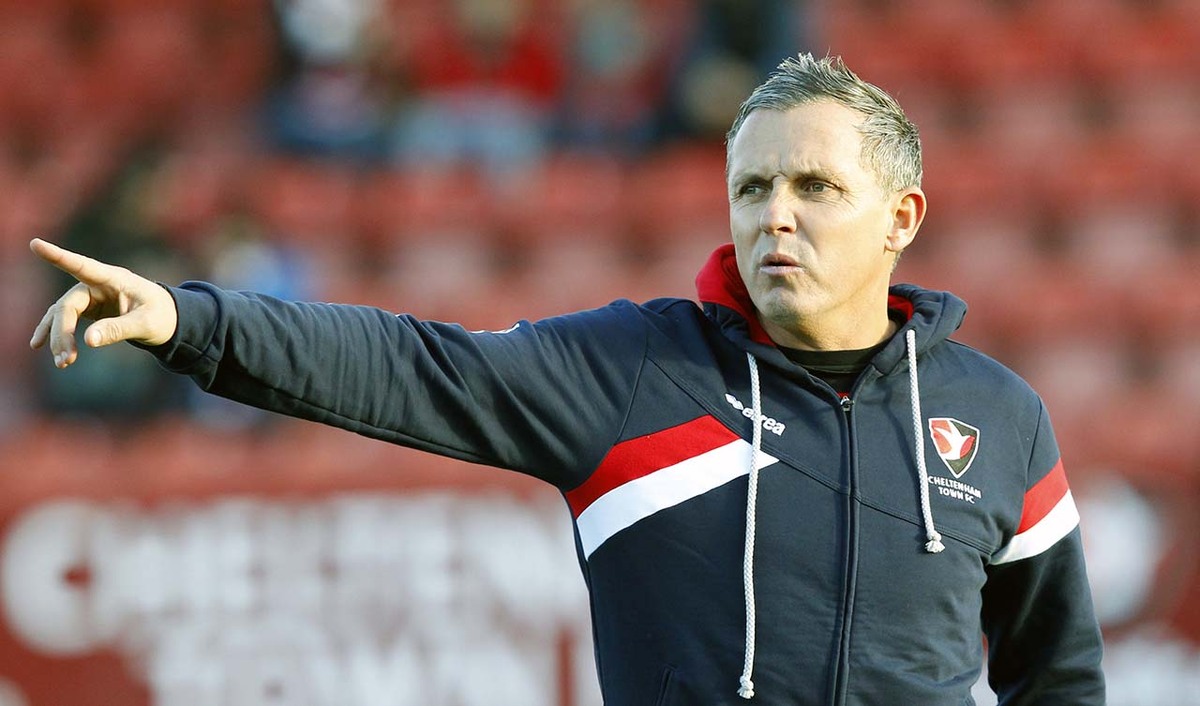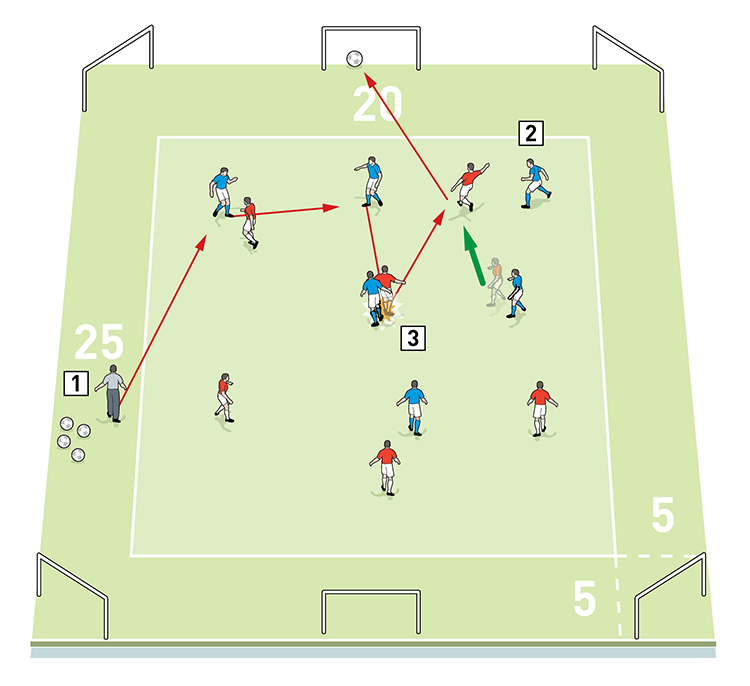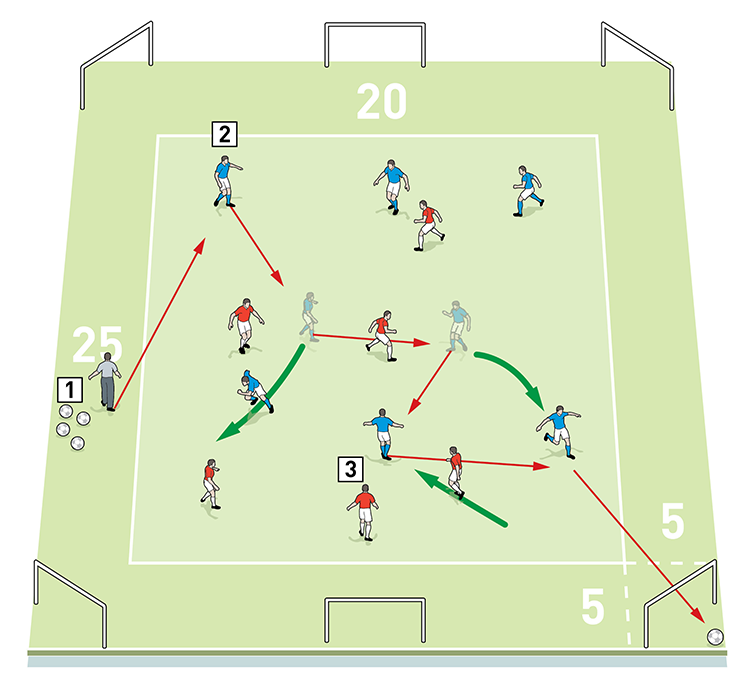Press & protect

| Area | 25x20 yards |
| Equipment | Balls, bibs, cones, 6 mini goals |
| No. of Players | 12 players |
| Session Time |
Press & protect: 16mins, 6v6 game: 16mins |
This is a simple defensive session that encourages players to press high and press aggressively. It also conditions players to respond with speed to a successful turnover of possession, resulting in quick counter-attacks.
The players really enjoy this session, as it’s fast and intense and it relies on quick reactions.
When their team is in possession, players have to make the extra man count before transferring the ball through the central zone.
Off the ball, the pressing team works really hard to force errors and steal possession, before trying to score in one of three mini goals. This session also teaches defenders to work as a team, shuffling across the central area as a unit to block through balls.
We will run this session once a week, close to match day. Although it uses a small area, it has everything in it that we want to see from the players in an 11v11 game: pressing high with aggression, regaining possession, and attacking quickly into the central or wide areas of the pitch.
What do I get the players to do?
Press & protect
We set up an area of 25x20 yards, with the length of the area split into two 10-yard end zones and a five-yard central zone. Three mini goals are positioned at each end, five yards outside the main area, as shown in the diagrams.
We’re using 12 outfield players, divided into two teams of six. The blues are the possession team and they start with three players in each end zone. The six red players all start in the central zone and they are the defending team.
The coach kicks off the game by passing the ball to the blue team in one of the end zones. As soon as the ball is live, two defenders from the centre can enter that end zone to press the ball, making it 3v2 in favour of the passing team. The possession players must make their overload count and should create an opening to pass the ball to a team mate in the opposite end zone to score a point, as shown [1a], either by passing through or over the centre zone. The four remaining defenders in the centre should work together to try and block all passing routes.
1a

2. Two red defenders from the centre enter the end zone to press the ball
3. The four remaining defenders should work together, shuffling across to block passing routes across the central zone
4. Under pressure from the red pair, the three blues must make their overload count and try to pass to their team mates in the opposite end zone to score a point
5. When the ball crosses the central zone, two more reds from the centre can follow the ball to try and win possession
As soon as the ball enters the end zone, two of the defenders from the centre can enter that zone to try to force a turnover of possession. If they succeed, the pressing pair must try to score in the one of the mini goals to earn a point, as shown [1b]. As soon as the ball has crossed the central zone, the original pressing pair must return to the middle from the opposite end, so there are always four defenders in the central zone to block passing routes.
1b

2. If the reds win possession they must try to score in one of the mini goals for a point
In each game, teams press for two minutes before switching roles. Teams play four games in each role.
How do I progress the session?
We can progress the session by restricting the possession players to passing through the central zone on the ground only, ruling out balls played over the top. We can also limit the team with the ball to two touches.
If the possession team keeps the ball for too long without transferring it across the centre, we allow a third defending player from the centre to join the press, eliminating the numerical advantage of the passers and forcing them to work quicker.
Another progression is to allow a third central player to join his two team mates in the end zone when they regain the ball, making it 3v3 when they try to score in the mini goals.
How would you put this into a game situation?
6v6 Game
We use the same basic set-up as before but we remove the zones, leaving one 25x20-yard playing area. The two teams play a 6v6 directional game and attempt to win possession and score in one of the three mini goals at the end they are attacking, as shown [2a/2b].
2a

2. The two teams play a 6v6 directional game and attempt to score in one of the three mini goals at the end they are attacking
3. Here the reds aggressively press high and win possession. They react quickly to counter-attack and score
2b

2. The possession team should make the space as big as possible to stretch the defending team
3. Look for players to punch their passes through the lines
We can progress this by playing a 9v9 game on a 60x40-yard pitch or an 11v11game on a full pitch.
What are the key things to look out for?
With the ball, we want to see players passing quickly, making space as big as possible and punching their passes through the lines. We also want to see them clipping the ball over the top of the central zone when necessary. If they lose possession, we want to see players react with speed, pressing or recovering as required.
Without the ball, we want to see players pressing as a team and blocking passing lanes as a unit. We also want to see players aggressively chasing the ball and counter-attacking quickly when they win possession.
What are the typical mistakes players might make and how do I avoid them?
With the ball, players can often show slow decision-making, make a poor choice of forward pass, and use the incorrect weight of pass.
Without the ball, players don’t always press as a team, they fail to communicate with each other, and can show slow reactions to the transition.
Editor's Picks
Attacking transitions
Deep runs in the final third
Using the goalkeeper in build-up play
Intensive boxes drill with goals
Penetrating the final third
Creating and finishing
My philosophy
Pressing initiation
Compact team movement
Coaches' Testimonials

Alan Pardew

Arsène Wenger

Brendan Rodgers

Carlos Carvalhal

José Mourinho

Jürgen Klopp

Pep Guardiola

Roy Hodgson

Sir Alex Ferguson

Steven Gerrard
Coaches' Testimonials

Gerald Kearney, Downtown Las Vegas Soccer Club

Paul Butler, Florida, USA

Rick Shields, Springboro, USA

Tony Green, Pierrefonds Titans, Quebec, Canada
Join the world's leading coaches and managers and discover for yourself one of the best kept secrets in coaching. No other training tool on the planet is written or read by the calibre of names you’ll find in Elite Soccer.
In a recent survey 92% of subscribers said Elite Soccer makes them more confident, 89% said it makes them a more effective coach and 91% said it makes them more inspired.
Get Monthly Inspiration
All the latest techniques and approaches
Since 2010 Elite Soccer has given subscribers exclusive insight into the training ground practices of the world’s best coaches. Published in partnership with the League Managers Association we have unparalleled access to the leading lights in the English leagues, as well as a host of international managers.
Elite Soccer exclusively features sessions written by the coaches themselves. There are no observed sessions and no sessions “in the style of”, just first-hand advice delivered direct to you from the coach.









